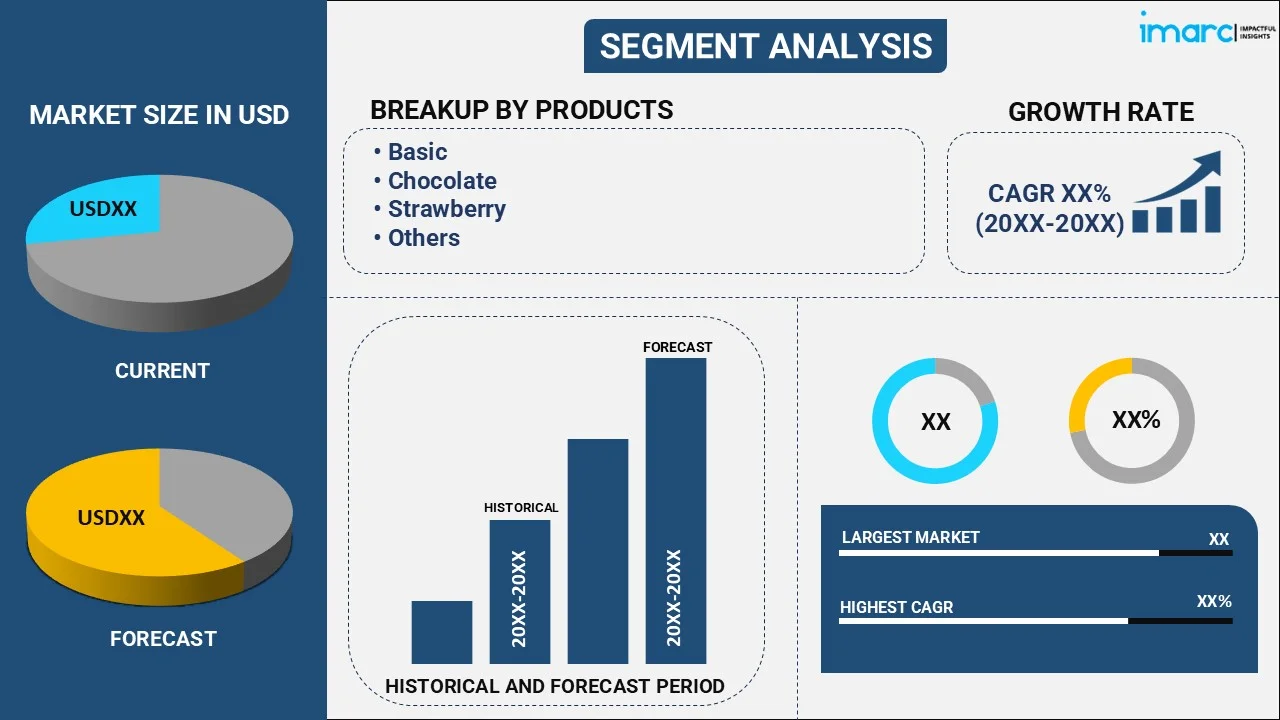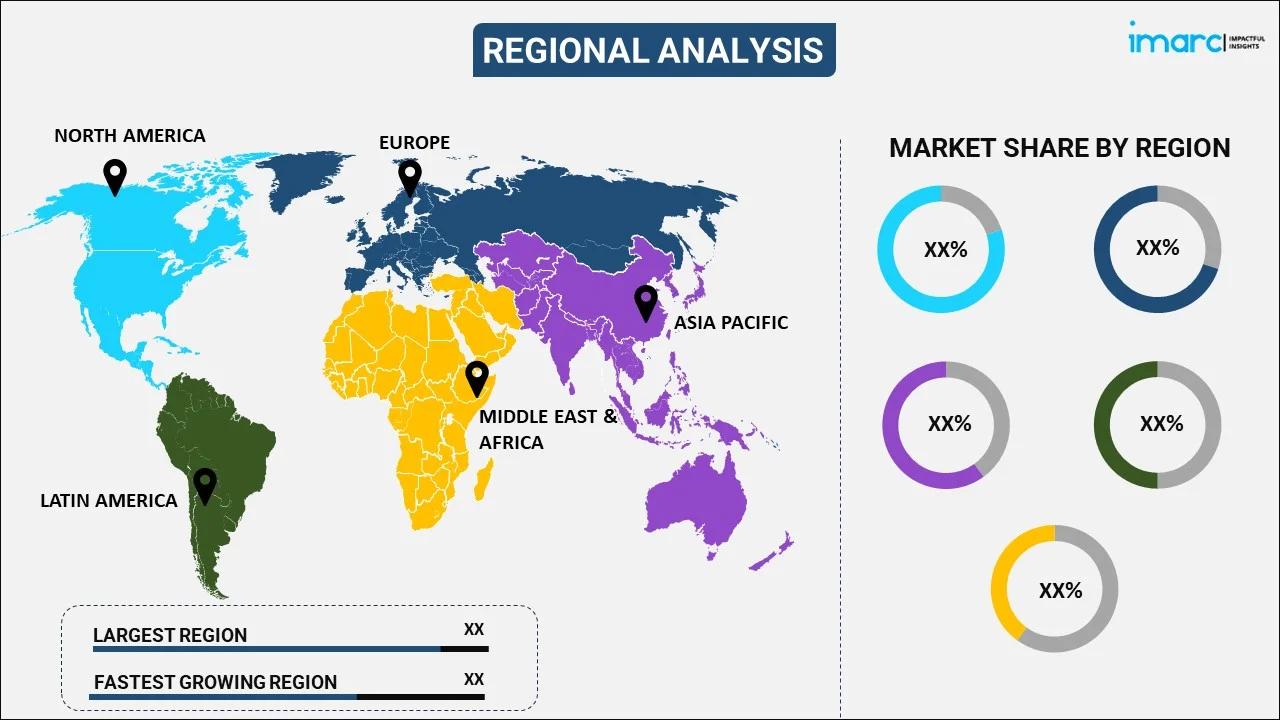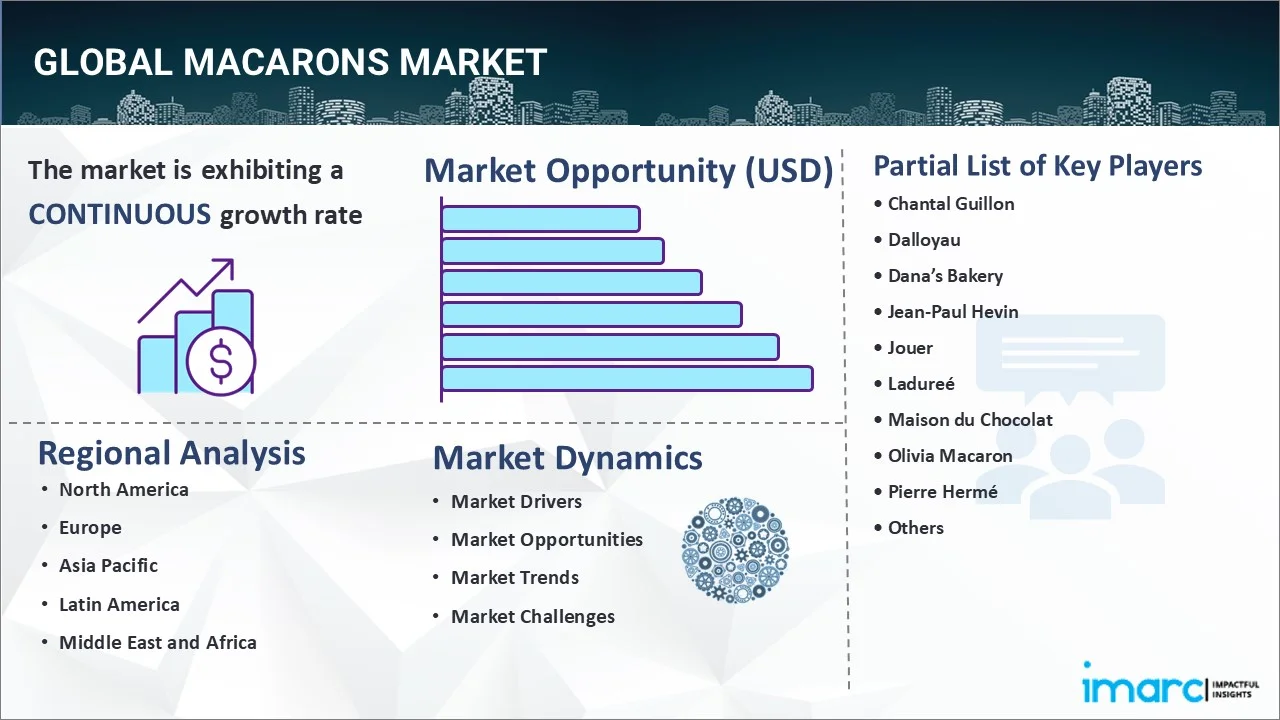
Macarons Market Report by Product (Basic, Chocolate, Strawberry, Lemon, Lavender Coconut, and Others), Distribution Channel (Supermarkets/Hypermarkets, Convenience Stores, Independent Retailers, Online Channel, and Others), and Region 2025-2033
Market Overview:
The global macarons market size reached USD 1,077.8 Million in 2024. Looking forward, IMARC Group expects the market to reach USD 1,715.4 Million by 2033, exhibiting a growth rate (CAGR) of 5.03% during 2025-2033. The rising awareness about the benefits of macarons, wide availability of macarons through online and offline distribution channels, and the growing number of restaurants, cafes, and bakeries represent some of the key factors positively influencing the market demand.
|
Report Attribute
|
Key Statistics
|
|---|---|
|
Base Year
|
2024
|
|
Forecast Years
|
2025-2033
|
|
Historical Years
|
2019-2024
|
|
Market Size in 2024
|
USD 1,077.8 Million |
|
Market Forecast in 2033
|
USD 1,715.4 Million |
| Market Growth Rate 2025-2033 | 5.03% |
A macaron is a meringue-based sandwich cookie manufactured with almond flour, egg whites, powdered sugar, and food coloring. It has a smooth top, ruffled edges, and a flat bottom and filled with buttercream, ganache, and fruit-based jam. It is moist, slightly cakey, and chewy and can be decorated with chopped almonds, walnuts, raisins, or cherry bits. It can be added to ice creams, pie fillings, and puddings to enhance their taste and texture. It acts as a quick energy source and nutrition and a rich source of vitamin E, magnesium, and potassium, which assists in maintaining a healthy immune system. As it can be consumed by individuals suffering from celiac disease or gluten sensitivity, the macarons market demand is rising across the globe.
Macarons Market Trends:
Increasing popularity of gourmet desserts
Macarons are frequently regarded as a high-end treat, synonymous with gourmet pastry shops and French culinary tradition. Their delicate texture and brilliant colors give the appearance of luxury, which appeals to people looking for premium sweets. The increased interest in artisanal cuisine is making consumers appreciate the skill and workmanship required to make macarons. This appreciation creates a preference for quality over quantity, prompting customers to select macarons as a sophisticated dessert option. The gourmet dessert craze is resulting in innovative flavor combinations and macaron fillings that go beyond standard tastes. This innovation appeals to adventurous foodies looking for one-of-a-kind and memorable culinary experiences. Gourmet treats are visually appealing, and macarons match this aesthetic wonderfully. Their bright appearance and sophisticated design make them ideal for social media sharing, which adds to their popularity in dessert culture.
Expansion of cafe culture
Increasing number of cafes and coffee shops are influencing the macarons market share. These restaurants frequently showcase macarons prominently on their menus, making them more accessible to a larger audience. Cafes seek to attract consumers by offering contemporary and visually appealing culinary offerings. Macarons fulfill this criterion perfectly because of their bright appearance and refined image, which encourages cafes to offer them as a distinctive item. Macarons go well with coffee, tea, and other beverages typically found in cafes. Because of their complementing character, they are an appealing alternative for consumers searching for a sweet treat to go with their drinks. Cafes function as social gathering places where people can enjoy food and beverages. The presence of macarons in these settings adds to their position as a fashionable and attractive snack, increasing customer interest. The café culture values high-quality ingredients and a positive client experience. Many cafes focus on procuring high-quality macarons, which corresponds to consumer expectations for premium items, enhancing their popularity.
Social media influence
Social media platforms favor visually appealing content, making macarons very shareable and desired to those looking for aesthetically pleasing cuisine. Their endorsements can considerably increase visibility and customer interest, as followers frequently trust their suggestions. Consumers frequently share their macaron-related experiences, including images of their purchases or creations. This user-generated content is authentic marketing, encouraging people to try macarons and increasing brand recognition. Recipes and methods for making macarons at home are widely available on social media channels. This encourages consumers to get more involved with the product, whether by creating it themselves or seeking out high-quality versions at local cafés and bakeries.
Key Market Segmentation:
IMARC Group provides an analysis of the key trends in each segment of the global macarons market, along with forecasts at the global, regional, and country level from 2025-2033. Our report has categorized the market based on product and distribution channel.
Product Insights:

- Basic
- Chocolate
- Strawberry
- Lemon
- Lavender Coconut
- Others
The report has provided a detailed breakup and analysis of the macarons market based on the product. This includes basic, chocolate, strawberry, lemon, lavender coconut, and others. According to the report, chocolate represented the largest segment.
Distribution Channel Insights:
- Supermarkets/Hypermarkets
- Convenience Stores
- Independent Retailers
- Online Channel
- Others
A detailed breakup and analysis of the macarons market based on the distribution channel has also been provided in the report. This includes supermarkets/hypermarkets, convenience stores, independent retailers, online channel, and others. According to the report, convenience stores represented the largest segment.
Regional Insights:

- North America
- United States
- Canada
- Asia Pacific
- China
- Japan
- India
- South Korea
- Australia
- Indonesia
- Others
- Europe
- Germany
- France
- United Kingdom
- Italy
- Spain
- Russia
- Others
- Latin America
- Brazil
- Mexico
- Others
- Middle East and Africa
The report has also provided a comprehensive analysis of all the major regional markets that include North America (the United States and Canada); Asia Pacific (China, Japan, India, South Korea, Australia, Indonesia, and others); Europe (Germany, France, the United Kingdom, Italy, Spain, Russia, and others); Latin America (Brazil, Mexico, and others); and the Middle East and Africa. According to the report, Europe was the largest market for macarons. Some of the factors driving the Europe macarons market included the increasing popularity of French cuisine, rising disposable income, and growing demand for gluten-free and vegan options.
Competitive Landscape:
The report has also provided a comprehensive analysis of the competitive landscape in the global macarons market. Detailed profiles of all major companies have also been provided. Some of the companies covered include:
- Chantal Guillon
- Dalloyau
- Dana’s Bakery
- Jean-Paul Hevin
- Jouer
- Ladureé
- Maison du Chocolat
- Olivia Macaron
- Pierre Hermé
- Richart
Kindly note that this only represents a partial list of companies, and the complete list has been provided in the report.
Macarons Market News:
- February 2024: Coco Bakery Inc., a subsidiary of Toronto-based Bond Bakery Brands, is set to receive an investment of C$683,000 (approximately USD505,895) from the Federal Economic Development Agency for Southern Ontario (FedDev Ontario). This funding will be used to acquire new equipment, which will more than double the company's production capacity for French macarons. Currently, Coco Bakery produces over 30,000 macarons, 15,000 eclairs, and 20,000 profiteroles daily. The investment is expected to create 20 new jobs and support the company's growth in both Canadian and U.S. markets.
- February 2024: Brioche Pasquier, a French bakery, launched limited-edition macaron packaging inspired by Netflix's Emily in Paris. This collaboration will feature two flavor collections: a classic assortment with flavors like Chocolate Hazelnut and Vanilla, and a fruit-inspired assortment including Fig with Poppy Seeds and Coconut. The campaign aims to attract both new customers and loyal fans of the series, supported by extensive marketing efforts across social media and in-store displays.
- August 2024: Ladurée, the iconic French patisserie, is set to open a café at The Ritz-Carlton, Pune, marking its entry into the city through a collaboration with the CK Israni Group. An exclusive creation tailored for Pune will be part of the menu, which includes signature French toasts, high tea options, avocado toasts, salads, sandwiches, and a variety of teas and coffees. It will also feature Ladurée's famous macarons and pastries. This opening is part of Ladurée's strategy to gradually expand its presence across India, following successful launches in Delhi and Mumbai.
Report Coverage:
| Report Features | Details |
|---|---|
| Base Year of the Analysis | 2024 |
| Historical Period | 2019-2024 |
| Forecast Period | 2025-2033 |
| Units | Million USD |
| Products Covered | Basic, Chocolate, Strawberry, Lemon, Lavender Coconut, Others |
| Distribution Channels Covered | Supermarkets/Hypermarkets, Convenience Stores, Independent Retailers, Online Channel, Others |
| Regions Covered | Asia Pacific, Europe, North America, Latin America, Middle East and Africa |
| Countries Covered | United States, Canada, Germany, France, United Kingdom, Italy, Spain, Russia, China, Japan, India, South Korea, Australia, Indonesia, Brazil, Mexico |
| Companies Covered | Chantal Guillon, Dalloyau, Dana’s Bakery, Jean-Paul Hevin, Jouer, Ladureé, Maison du Chocolat, Olivia Macaron, Pierre Hermé, Richart, etc. |
| Customization Scope | 10% Free Customization |
| Post-Sale Analyst Support | 10-12 Weeks |
| Delivery Format | PDF and Excel through Email (We can also provide the editable version of the report in PPT/Word format on special request) |
Benefits for Stakeholders:
- IMARC’s report offers a comprehensive quantitative analysis of various market segments, historical and current market trends, market forecasts, and dynamics of the macarons market from 2019-2033.
- The research study provides the latest information on the market drivers, challenges, and opportunities in the global macarons market.
- The study maps the leading as well as the fastest growing regional markets. It further enables stakeholders to identify the key country-level markets within each region.
- Porter's five forces analysis assist stakeholders in assessing the impact of new entrants, competitive rivalry, supplier power, buyer power, and the threat of substitution. It helps stakeholders to analyze the level of competition within the macarons industry and its attractiveness.
- Competitive landscape allows stakeholders to understand their competitive environment and provides an insight into the current positions of key players in the market.
Key Questions Answered in This Report
The global macarons market was valued at USD 1,077.8 Million in 2024.
We expect the global macarons market to exhibit a CAGR of 5.03% during 2025-2033.
The rising demand for macarons with natural, additive-free, and organic ingredients, along with the increasing consumption of keto macarons with low carbs and calorie content among health-conscious consumers, is primarily driving the global macarons market.
The sudden outbreak of the COVID-19 pandemic has led to the changing consumer inclination from conventional brick-and-mortar distribution channels towards online retail platforms for the purchase of macarons.
Based on the product, the global macarons market has been segregated into basic, chocolate, strawberry, lemon, lavender coconut, and others. Among these, chocolate currently holds the largest market share.
Based on the distribution channel, the global macarons market can be bifurcated into supermarkets/hypermarkets, convenience stores, independent retailers, online channel, and others. Currently, convenience stores exhibit a clear dominance in the market.
On a regional level, the market has been classified into North America, Asia Pacific, Europe, Latin America, and Middle East and Africa, where Europe currently dominates the global market.
Some of the major players in the global macarons market include Chantal Guillon, Dalloyau, Dana’s Bakery, Jean-Paul Hevin, Jouer, Ladureé, Maison du Chocolat, Olivia Macaron, Pierre Hermé, Richart, etc.
Need more help?
- Speak to our experienced analysts for insights on the current market scenarios.
- Include additional segments and countries to customize the report as per your requirement.
- Gain an unparalleled competitive advantage in your domain by understanding how to utilize the report and positively impacting your operations and revenue.
- For further assistance, please connect with our analysts.

 Inquire Before Buying
Inquire Before Buying
 Speak to an Analyst
Speak to an Analyst
 Request Brochure
Request Brochure
 Request Customization
Request Customization




.webp)




.webp)












